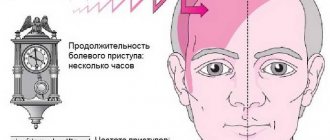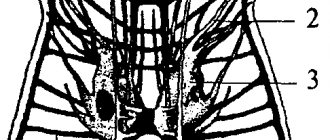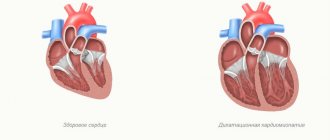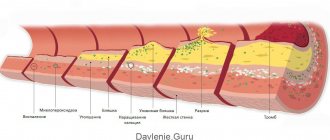The circle of Willis is a group of arteries that lies at the base of the brain and saturates all its areas with blood if pathologies such as severe narrowing, spasm or blockage of any feeding artery occur, which indicates an important role in the process of general cerebral blood supply. The circle of Willis performs a compensatory (reimbursing) function in cases where cerebral circulation is impaired.
Structure of the Circle of Willis
The anatomy of the structure normally assumes the formation within the circulatory system of a closed ring - the Circle of Willis. The main arteries that make up the Circle of Willis:
- Forebrain (primary section).
- Front connecting.
- Internal carotid (supracuneiform department).
- Rear connecting.
- Posterior brain (primary section).
Numerous arteries branch off from the Circle of Willis, forming a branched network, the anatomical structure of which allows, if necessary, to nourish any part of the brain. Various deviations in the formation of the structure of the system are more often congenital anomalies, less often they arise as a result of previous infectious diseases, traumatic brain injuries, vascular pathologies (atherosclerosis, impaired neurohumoral regulation).
If the circle is closed, is it good or bad?
When the VC is closed, the coordinated work of all vessels of a given organ occurs. Blood circulation occurs through all branches of the arterial system. The transit of blood flow occurs instantly to the place where its deficiency is felt.
Blood is collected from two pools:
- Vertebrobasilar basin type;
- Great circle pool type of carotid arteries.
A vicious circle is a normative indicator and means that if a pathology occurs in an organ, the blood supply will be as accessible and compensated as possible.
A closed VC is good because it guarantees that in the event of damage to one of the arteries, the brain will work normally and hypoxia will not develop, with all the ensuing complications.
The circle of Willis of an open type is a pathological anomaly that provokes disturbances in the blood supply to the brain matter.
The system supplies blood only to the part to which it has access, but the organ does not fully perform its function.
Types of anomalous deviations during formation:
- Aplasia of the posterior as well as anterior communicating vessels;
- The posterior communicating vessels are divided into three arteries (trifurcation);
- Aplasia of the basilar vessel with the circle of Willis.
Functions of the circle of Willis
The main function of the system is the regulation of cerebral hemodynamics. If there is a decrease in the blood supply to a certain area of the brain, the system represented by the VC redirects blood flow in such a way as to replace the blood lost in areas that are deficient.
Thanks to the system, many anomalies in the development of cerebral vessels (aplasia, hypoplasia) are not accompanied by neurological symptoms and often become an incidental finding during a diagnostic examination prescribed for another reason.
Treatment and prevention
Often, patients learn about pathologies of the vascular system only after a comprehensive diagnosis, to which a doctor refers them due to various health problems. It is not surprising that people are thinking about ways to treat vascular disorders.
First of all, in the human circulatory system, it is necessary to prevent decompensation, try not to overload the vessels and maintain blood flow at a physiological level. To do this, it is necessary to carry out a number of specific activities:
- regular measurement of cholesterol levels;
- timely treatment of heart and vascular diseases, VSD;
- regular monitoring of blood clotting indicators;
- normalization of pressure.
If a person experiences regular migraine attacks, especially when it comes to conditions with visual disturbances, it is imperative to clarify the diagnosis with a specialist. The most informative diagnostic methods are transcranial Doppler ultrasound and MRI.
If pathology in the structure of the arteries is detected, regular medical examinations should be carried out, visiting a cardiologist, therapist, etc. It is necessary to take courses of vascular medications, including Cavinton, as well as Pentoxifylline. To improve blood supply to tissues and speed up metabolism, nootropics are often prescribed, including:
- Vinpotropil.
- Nootropil.
- Phezam.
In addition, it is necessary to undergo annual treatment with antioxidant and metabolic drugs. To support the functioning of brain neurons, you should take vitamin B.
People who have pathologies in the structure of bypass blood supply pathways (collaterals) need to maintain a positive tone, avoid nervous tension and eat right.
Development options
The classic pattern of the Circle of Willis is found in 25-38% of people; the remaining variants are developmental anomalies that differ from the norm, which can worsen the compensatory properties of the system. Among the predominant pathologies of the structure are vascular aneurysms (persistently dilated areas with impaired tone of the vascular wall). Other anomalous structural options characteristic of the Circle of Willis:
- Underdevelopment of the connecting artery.
- Absence or underdevelopment of the anterior artery in the anterior section
- Absence or underdevelopment of the posterior artery in the anterior section.
- Trifurcation (division into 3 branches) of an artery, most often the internal carotid in the posterior section. Occurs with a frequency of 19% of cases.
- Aplasia (absence of part) of the arteries, most often the posterior communicating ones. Occurs with a frequency of 17.5% of cases.
In 14% of cases, the picture of an anomalous closed or open Circle of Willis combines several non-classical variants of vessel formation. In 11.5% of cases, the circulatory system is represented by rare variants. In a normal circuit, the Circle of Willis is completely closed, which means that the blood supply system works well, compensating for the deficiency of blood flow if there are abnormalities in the development of feeding vessels or blood flows poorly to the brain tissue.
A patient with classic VK, if one or two vertebral arteries are blocked, is able to survive because the system redistributes the direction of blood flow, ensuring normal blood supply to all parts. If the circle of Willis is not closed, this means that the compensatory capabilities of the circulatory system are reduced. Cerebrovascular pathologies are one of the common causes of mortality.
If, due to the progression of atherosclerosis or other vascular pathologies, obstruction of the supplying arteries occurs, the abnormal system of auxiliary, compensatory blood flow does not work. The most common consequence of an open circle of Willis is acute deterioration of blood circulation in the brain structures and stroke. If the development of the circle of Willis corresponds to the classical scheme, a natural redistribution of blood flow occurs in the following cases:
- Compression of the feeding artery in the neck due to a sharp turn of the head.
- Spasms of feeding vessels due to a violation of neurohumoral regulation.
- Obstruction (blockage) of blood vessels with an embolus or thrombus.
The functionality of the Circle of Willis is not fully realized if it is open or if such variants of the network are observed that this leads to difficulty in compensatory blood flow. Statistics show that patients with worsening cerebral circulation almost always exhibit abnormalities in the structure of the circulatory system supplying the brain.
Typical structural consequences when the circle of Willis is open are associated with a decrease in the intensity of blood circulation and uneven distribution of blood flow. As a result, various disorders occur - ischemia, atrophy, necrosis of individual areas, TIA (transient ischemic attack).
To judge whether it is good or bad that the circle of Willis is open, it is important to determine how much deviations from the classical structure affect the regulation of hemodynamics. With some variants of the system, there is a predisposition to the formation of aneurysms, the rupture of which causes a hemorrhagic stroke.
With chronic deterioration of blood supply to certain zones, ischemic stroke develops. If the circle of Willis is open, this indicates the absence of important arteries (usually one or both posterior connecting ones), which can lead to serious consequences - stroke, disability, death.
Causes of structural anomalies
Vascular anomalies form during intrauterine development of the fetus due to disorders of embryogenesis. This can be caused by adverse external influences, diseases of the expectant mother or genetic factors.
If there are no connecting branches at all, experts talk about the complete openness of the circle of Willis . If the vessels are formed, but their diameter is smaller than the anatomical norm, or they are underdeveloped, it is considered that the circle is not completely open.
The most common causes of openness are:
- The anterior part of the ring is the absence of the anterior communicating artery, trifurcation of the anterior cerebral artery.
- Posterior part - absence of the posterior communicating artery, basilar artery, posterior trifurcation of the internal carotid artery.
Anomalies in the structure of the arterial system of the circle of Willis are felt only when it is necessary to bypass the blood flow. This can be due to the formation of an atherosclerotic plaque, a blood clot, severe spasm, or rupture of a vessel.
Signs of abnormal structure
Detection of signs of an open circle of Willis and other pathologies of the circulatory system of the brain at an early stage allows for timely treatment of disorders. Symptoms of vertebrobasilar insufficiency in patients with anomalies in the development of the circulatory system appear at the slightest disturbance of blood flow in the vertebral artery. Signs of chronic ischemic processes in the brain provoked by circulatory disorders:
- Pain in the head area.
- Dizziness, transient confusion.
- Noise, buzzing in the ears.
- Deterioration of cognitive abilities - memory, mental activity.
- Violation of sleep and wakefulness (insomnia at night, drowsiness during the day).
If a lack of blood flow is observed in the carotid system, the patient may additionally experience symptoms such as numbness, weakness in the limbs, and speech dysfunction. If blood flow deteriorates in the vertebral arteries, symptoms appear: ataxia, impaired motor coordination, difficulty maintaining the body in balance. If such symptoms are present, it is recommended to undergo an instrumental examination to identify the causes of the disorders.
About the structure of this part of the circulatory system
There are many options for constructing the arterial ring of the base of the brain, but its mandatory components are arteries:
- forebrain (its initial fragment);
- posterior medulla (at its initial segment);
- connecting (front and rear);
- internal carotid (its suprasphenoid fragment).
The main vascular arteries are 2 carotid and 2 vertebral arteries (one on each side of the body). Carotid animals enter the cranial cavity through the carotid canal, which passes through the pyramid of the temporal bone and opens at its apex; vertebrates enter by passing the foramen magnum.
The blood supply is created by intermediate “bridges” that have individual characteristics: they can be completely absent, be in a state of aplasia, hypoplasia, or be tripled (the presence of three elements instead of two, or the phenomenon of trifurcation).
In the classically symmetrical version, the vertebral arteries merge to form one powerful basilar (main) one, running along the pons and giving branches to supply the cerebellum and medulla oblongata. Anteriorly, it is divided into 2 posterior connective (right and left), at the same level creating also 2 posterior cerebral.
At the level of its confluence with the internal carotid, on both sides of the anastomosis, the central cerebral arteries (left and right) branch in the distal direction. The branches of both internal carotid cells close in front, forming a semicircle, from which 2 parallel anterior cerebral arteries extend forward.
The vessels of the anterior half (carotid and anterior cerebral) are distinguished by the greatest stability of development, while the anatomy of the posterior cerebral and connecting parts is characterized by great variability in branching.
In the first case (in the absence of connecting branches), the communication between the anterior and posterior sections is completely absent; in the second (with their preservation, but in a state of stenosis or hypoplasia), they speak of incomplete opening of the basilar circle, allowing it to function not at full capacity.
Anomalies in the structure of blood vessels may not manifest themselves for years, until reaching an age when the changes become stable and the level of cerebral circulation becomes unstable, but they can appear already in young years.
The most constant ones include the appearance of:
- headaches;
- dizziness;
- decreased attention, memory (in severe cases, intellectual capabilities).
Due to the presence of cerebral ischemia involving fine brain structures, both neurological and mental abnormalities appear - from emotional instability to neuroses and panic attacks.
The most characteristic symptom of circle of Willis pathology is migraine attacks. The most susceptible to it are people with open circles or anomalies in the development of the posterior half of the system:
- posterior trifurcation;
- hypo- or aplasia of the posterior communicating branches.
Due to ischemia of the areas of the brain responsible for vision, the onset of an attack is preceded by the appearance of a visual aura (bright zigzags, flashes and sparks in the eyes).
Other symptoms of insufficient blood supply are signs of DEP (dyscirculatory encephalopathy) with a disorder in both the emotional-volitional and purely physical spheres - from unreasonable weakness to decreased ability to work.
The peak of dysfunction in the abnormal structure of the basal circle is the development of stroke with the development of paralysis and paresis, sensory and motor disorders, and in severe cases - with the onset of coma.
The emergence and development of an aneurysm may also not manifest itself for decades and is often an accidental finding during the study of cerebral vessels.
Deviations in the development of structures of the circle of Willis occur, as a rule, during intrauterine development, the course of which can be caused by abuse on the part of the pregnant mother:
- her smoking;
- her use of alcohol or drugs;
- overdose of sleeping pills and sedatives;
- unauthorized use of medications not prescribed by a doctor.
The course of pregnancy can be affected by chronic or acute stress of high intensity, viral infection, etc.
The cessation of the functioning of the existing and developed system of messages at the base of the brain can be caused by both the same chronic household intoxications and changes in the properties of blood (due to its high coagulability), as well as diseases that cause degeneration of the vascular wall or narrowing (closing) of the lumen of blood vessels:
- atherosclerosis;
- thrombosis;
- fat or air embolism when large arteries are injured by sharp edges of bones during their fracture, or other acute and chronic causes.
Diagnosis of pathologies
Angiography of elements of the circulatory system of the brain is a priority method for detecting pathologies. Other instrumental methods:
- Doppler ultrasound.
- Interventional angiography of selective type.
- CT angiography, MR angiography.
The conclusion after an MRI study of the circulatory system in the area of the brain and the circle of Willis confirms or refutes the presence of non-classical development options. Instrumental examination makes it possible to determine the degree of patency and features of the morphological structure of blood vessels.











